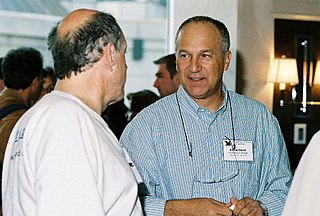
The unified modeling language (UML) is a general-purpose visual modeling language that is intended to provide a standard way to visualize the design of a system.
Software configuration management (SCM), a.k.a. software change and configuration management (SCCM), is the software engineering practice of tracking and controlling changes to a software system; part of the larger cross-disciplinary field of configuration management (CM). SCM includes version control and the establishment of baselines.
A software company is an organisation — owned either by the state or private — established for profit whose primary products are various forms of software, software technology, distribution, and software product development. They make up the software industry.
The rational unified process (RUP) is an iterative software development process framework created by the Rational Software Corporation, a division of IBM since 2003. RUP is not a single concrete prescriptive process, but rather an adaptable process framework, intended to be tailored by the development organizations and software project teams that will select the elements of the process that are appropriate for their needs. RUP is a specific implementation of the Unified Process.
The following outline is provided as an overview of and topical guide to software engineering:
Requirements engineering (RE) is the process of defining, documenting, and maintaining requirements in the engineering design process. It is a common role in systems engineering and software engineering.

Unicom System Architect is an enterprise architecture tool that is used by the business and technology departments of corporations and government agencies to model their business operations and the systems, applications, and databases that support them. System Architect is used to build architectures using various frameworks including TOGAF, ArchiMate, DoDAF, MODAF, NAF and standard method notations such as sysML, UML, BPMN, and relational data modeling. System Architect is developed by UNICOM Systems, a division of UNICOM Global, a United States–based company.
I-Logix was a provider of collaborative Model-driven development (MDD) solutions for systems design and software development, particularly focused on real-time embedded applications. Founded in 1987 and based in Andover, Massachusetts, the company specialized in products that facilitated collaboration among engineers working on embedded systems. Additionally, I-Logix was a member of the UML Partners, a consortium dedicated to the development of the Unified Modeling Language (UML).

David Harel is a computer scientist, currently serving as President of the Israel Academy of Sciences and Humanities. He has been on the faculty of the Weizmann Institute of Science in Israel since 1980, and holds the William Sussman Professorial Chair of Mathematics. Born in London, England, he was Dean of the Faculty of Mathematics and Computer Science at the institute for seven years.
Atego was a software development corporation headquartered in the United States and the United Kingdom with subsidiaries in France, Germany, and Italy. Formed from Interactive Development Environments, Inc. and Thomson Software Products, it was called Aonix from 1996 until 2010. It was acquired by PTC in 2014.
Model-driven engineering (MDE) is a software development methodology that focuses on creating and exploiting domain models, which are conceptual models of all the topics related to a specific problem. Hence, it highlights and aims at abstract representations of the knowledge and activities that govern a particular application domain, rather than the computing concepts.

The systems modeling language (SysML) is a general-purpose modeling language for systems engineering applications. It supports the specification, analysis, design, verification and validation of a broad range of systems and systems-of-systems.
Telelogic AB was a software business headquartered in Malmö, Sweden. Telelogic was founded in 1983 as a research and development arm of Televerket, the Swedish department of telecom. It was later acquired by IBM Rational, and exists under the IBM software group.
Rational Rose was a development environment for Unified Modeling Language. It integrates with Microsoft Visual Studio .NET and Rational Application Developer. The Rational Software division of IBM, which previously produced Rational Rose, wrote this software.

Rational Software Modeler (RSM), made by IBM's Rational Software division, is a Unified Modeling Language (UML) 2.0-based visual modeling and design tool. Rational Software Modeler is based on the Eclipse open-source software framework and is used for visual modeling and model-driven development (MDD) with UML for creating applications and web services. IBM ceased marketing Rational Software Modeler in 2010 and ended support for it in 2015. Much of the same functionality is now available through Rational Software Architect.
Rational Synergy is a software tool that provides software configuration management (SCM) capabilities for all artifacts related to software development including source code, documents and images as well as the final built software executable and libraries. Rational Synergy also provides the repository for the change management tool known as Rational Change. Together these two tools form an integrated configuration management and change management environment that is used in software development organizations that need controlled SCM processes and an understanding of what is in a build of their software.
UML state machine, formerly known as UML statechart, is an extension of the mathematical concept of a finite automaton in computer science applications as expressed in the Unified Modeling Language (UML) notation.
Rational Dynamic Object Oriented Requirements System (DOORS) (formerly Telelogic DOORS) is a requirements management tool. It is a client–server application, with a Windows-only client and servers for Linux, Windows, and Solaris. There is also a web client, DOORS Web Access.

YAKINDU Statechart Tools (YAKINDU SCT) is a tool for the specification and development of reactive, event-driven systems with the help of finite-state machines. It comprises a tool for the graphical editing of statecharts and provides validation, simulation, and source code generators for various target platforms and programming languages. YAKINDU Statechart Tools are available with standard and professional editions, with no-cost licenses for non-commercial resp. academic usage. Users are coming from both industry and academia.






